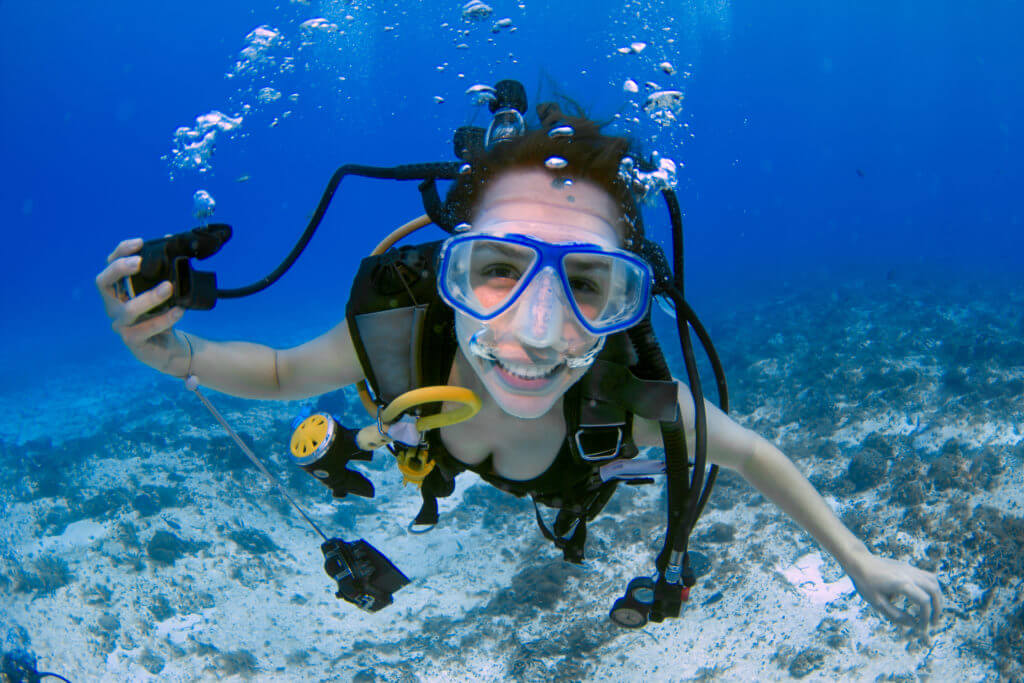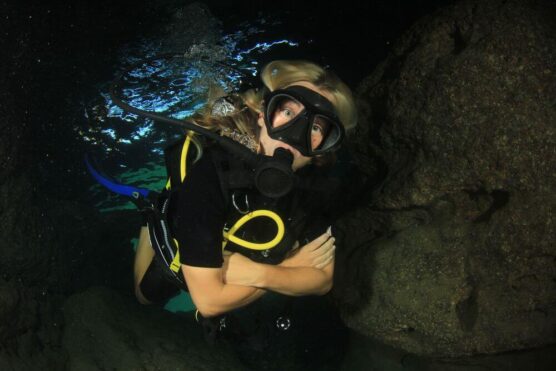
Types of Scuba Regulators
When people talk about different types of scuba regulators they’re referring to the different mechanisms by which regulators operate as well as the features they have.
These mechanisms and features influence the overall cost of the regulator and the type of diving that it’s best suited for.
You can use the information on this page in two ways:
- As a buyers guide to be read alongside our Best Scuba Regulator Reviews.
- As an expansion piece on the main info article: Scuba Octopus Setup.

1) Unbalanced or Balanced?
- Balanced – Most modern scuba octopus setups come in the balanced form. Balanced regulators compensate for depth and decreasing air tank pressure by equalising the air pressure on both sides of the valve. This allows you to breathe through them much more easily. Balanced regulators are universally preferred but they do tend to be a bit pricier.
- Unbalanced – Unbalanced regulators use piston and diaphragm designs and ‘breathe’ a little harder, especially as your tanks air diminishes as well as when you descend and pressure increases. However, unbalanced regulators do tend to be a little cheaper.
2) Piston VS Diaphragm First Stage
The piston or diaphragm controls and reduces air pressure from a high pressure to a moderate pressure in the first stage, making it safe to be breathed. (More info on this here!)
Piston Regulators – the external pressure acts on a piston which moves inside the first stage. Piston regulators offer a greater air flow rate and generally have only one moving part. They are usually more expensive, however their overall maintenance cost is lower and they tend to be more reliable.
Diaphragm Regulators have many moving parts, yet are more simple to manufacture and subsequently are cheaper. They are often preferred by cold water divers because they are less likely to free flow in cold water. That said, if a regulator has environmental sealing and heat exchanger fins; a diaphragm mechanism is in no way essential.
3) Yoke or Din?
There’s two types of coupling fittings which are used to a attach a regulators 1st stage to the tank.
- Yoke couplings are clamp type mountings, which are placed over the tank valve and then tightened into place. These are the most common type of fitting and if you ever borrowed a scuba regulator from a diving centre, it was probably a yoke style one.
- Din fittings are threaded valves, wherein you screw the regulator into the tank valve. These are the only coupling that can fit with high pressure tanks. This only really comes in handy for industrial divers or tech divers.
Most scuba regulator manufacturers offer conversion kits that allow the fitting type to change. This means a Din style regulator can be equipped with a yoke adaptor or a yoke style regulator can be equipped with a din adaptor.
Generally speaking, I’d recommend that you go for a yoke-style regulator. It’s the most common coupling fitting for the extremely popular aluminium 80 tanks employed by so many dive schools and liveaboards. You’re highly unlikely to need a Din adaptor unless you dive for a living! Click on the following link to read more about Dins Vs Yokes!
4) Ports and Hoses
Ideally, your scuba octopus setup should come with at least two high-pressure ports, and four low-pressure ports. If there are more ports available, this allows you to customise your setup further. That, said unless you plan on making some serious mods to your gear, 2 high pressure ports and 4 low pressure ports is ample.
When picking a regulator, try to go for a 1st stage that has the ability to attach all your accessory hoses in an effective streamlined setup. High end regulators’ first stages will be shaped in a way that let’s you aim the hoses in the direction you want, which makes your setup more streamlined and simple whilst also preventing hoses from getting twisted or tangled.
You’ll also find first stages that are designed with some ports on a section that swivels, kind of like one of those rotating turrets on the Death Star. The function of this isn’t to take down rebel scum, but to make it easier to get the hoses where you want them whilst also giving you more versatility in your setup configuration.
You can read more about regulator hoses and types at Simply Scuba.
5) Environmentally Sealed Regulator / Cold Water
This is a scuba regulator where the first stage is environmentally sealed, which means that water is kept out, preventing contamination in dirty water or icing in cold water.
The main advantage of an environmentally sealed regulator is that it prevents any freezing issues in the first stage, when diving in cold water. It also doesn’t require such frequent maintenance.
The only real disadvantage of an environmentally sealed regulator is an increase in expense when it does go to get serviced due to the fact that there’s an extra step in the overhaul process. For cold water diving, an environmentally sealed regulator is essential!
Some cold water regulators also have an additional feature called heat exchanger fins which in truth look more like ribs. These fins / ribs increase the surface area around the first stage which dissipates the cold that results from gas expansion, whilst drawing in the warmth of surrounding water. Thus they make a regulator even more suited for the most extreme of cold water environments.
If you’re wandering what exactly cold water diving is and the other gear you’ll need for such a mission – ask Dive In.

6) Travel Regulator
Technically, there’s not really any such thing as a “travel regulator”. However, you do get some scuba regulators which are a little more compact and light than others. Do note though, no scuba regulator is insanely heavy and they’re pretty much all the same shape, so the difference will not be huge!
If you’re trying to save space and weight with your scuba gear, it’s much more sensible to invest in a Travel BCD.
7) Durability
Generally, regulator 1st stages are made from marine brass which is then chrome plated to provide extra protection. A tougher and more durable coating called Physical Vapour Deposition (PVD) can now be found on higher spec regulators.
At the end of the day, most 1st stage regulators will be tough enough to take a knock, but if you want to get something extra durable because you enjoy throwing your gear at oncoming traffic or something, go for a strong metallic first stage with a PVD coating.
Diving Squad DEBRIEFING:
And there you have it! The fundamental differences between different types of scuba regulators. Whilst it’s possible to delve into these differences further, via clicking on the links above, you really only need to know more if you’re planning on becoming a tech or industrial diver.
For any recreational diver looking to understand diving regulators better, this really is all you’ll need to know. Give yourself a great big wet slap on the back.
- Read more about the Scuba Octopus Setup
- Check out our Best Scuba Regulator Reviews
Support the Squad!
Some of the links in our content are affiliate links. This means that if you buy a product, book a liveaboard, book accommodation or purchase insurance, we earn a small commission at no extra cost to you. Thanks!